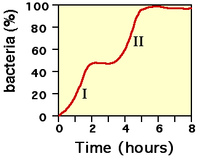Lac operon
|
|
The lac operon is a DNA sequence that governs the production of three proteins, including two enzymes for transporting and metabolizing lactose in the bacterium Escherichia coli (E. coli). In the absence of lactose, the lac represor protein binds to the operator (a part of the DNA sequence), inhibiting the production of the three proteins. Lactose, however, binds to the repressor, causing a change in it's shape (this is termed allosteric control) that prevents it from binding to the operator DNA, and therefore allows the three proteins to be produced. When the polycistronic mRNA of the lac operon is transcribed (by ribosomes), three proteins are produced: β-galactosidase (or LacZ), lactose permease (or LacY) and transacetylase (or LacA). The lac operon is considered the canonical example of prokaryotic gene regulation.
| Contents |
Discovery
It is traditional to give three letter codes for prokaryotic genes and proteins; "Lac" refers to a group of three enzymes, two of which are involved in the metabolism of the sugar lactose. The three are grouped together on the bacterial chromosome and co-transcribed (and so form an operon). The experimental microorganism used by Jacob and Monod was the common laboratory bacterium, E. coli, but many of the basic regulatory concepts (described below) that were discovered by Jacob and Monod are fundamental to cellular regulation in organisms. The key idea is that E. coli conserves cellular resources and energy by not making the three Lac proteins when there is no need to metabolize lactose, such as when other sugars like glucose are available. The key question was 'how does E. coli control certain genes in response to metabolic needs?
During World War II, Monod was testing the effects of combinations of sugars as nutrient sources for E. coli. He found that bacteria grown with two different sugars often displayed two phases of growth. For example, if glucose and lactose were both provided, glucose would be metabolized first (growth phase I, see Figure 2) and then lactose (growth phase II). But why was there a delay between the two growth phases?
The operon

Regulation by lactose
E. coli makes a specific repressor protein, called LacI that is located on a distant part of the bacterial chromosome (this is termed trans-regulation), it is constitutively expressed (that is it is always produced by E. coli). LacI binds to the operator sequence located downstream of the promoter, preventing expression of lactose metabolism genes. However, lactose binds to LacI (the repressor protein) and allosterically prevents it from binding to the operator site.
Regulation by cAMP
At high glucose concentrations production of the cellular signalling molecule cAMP is very low. When the glucose has been depleted at the end of growth phase I, cAMP levels begin to increase. The bacterium makes an activator protein called CAP which is able to dimerize when bound by cAMP. The CAP homodimer (two identical molecules forming a dimer) binds to the promoter (an upstream element) and recruits RNA polymerase, which transcribes mRNA from the operon.
This dual regulation causes the lactose metabolism enzymes to be made in small quantities in the presence of glucose and lactose (sometimes called leaky expression) due to the lactose inhibiting LacI binding of the operator, but at high cAMP concentrations and in the presence of lactose there are high levels of expression (Phase II in Figure 2). Leaky expression is necessary in order to allow for metabolism of some lactose after the glucose source is expended, but before lac expression is fully activated. In summary:
- When lactose is absent then there is no Lac enzyme production (the operator has LacI bound to it).
- When lactose is present but a prefered carbon source (like glucose) is also present then a small amount of enzyme is produced (LacI is not bound to the operator).
- When lactose is the favoured carbon source (for example in the absence of glucose) cAMP-CAP bind to the promoter and Lac enzyme production is maximised.
So why is there a delay between the two growth phases? The CAP regulatory protein has to assemble on the lac operator, resulting in an increase in the production of lac mRNA. More available copies of the lac mRNA results in the production (see translation) of significantly more copies of LacZ (β-galactosidase, for lactose metabolism) and LacY (lactose permease to transport lactose into the cell) are produced. Lower amounts of the transacetylase (LacA) are produced and it's role in lactose metabolism is unclear, it's lower level of expression is thought to be due to it's position on the operon (see diagram). After a delay needed to increase the level of the lactose metabolizing enzymes, the bacteria enter into a new rapid phase of cell growth.

